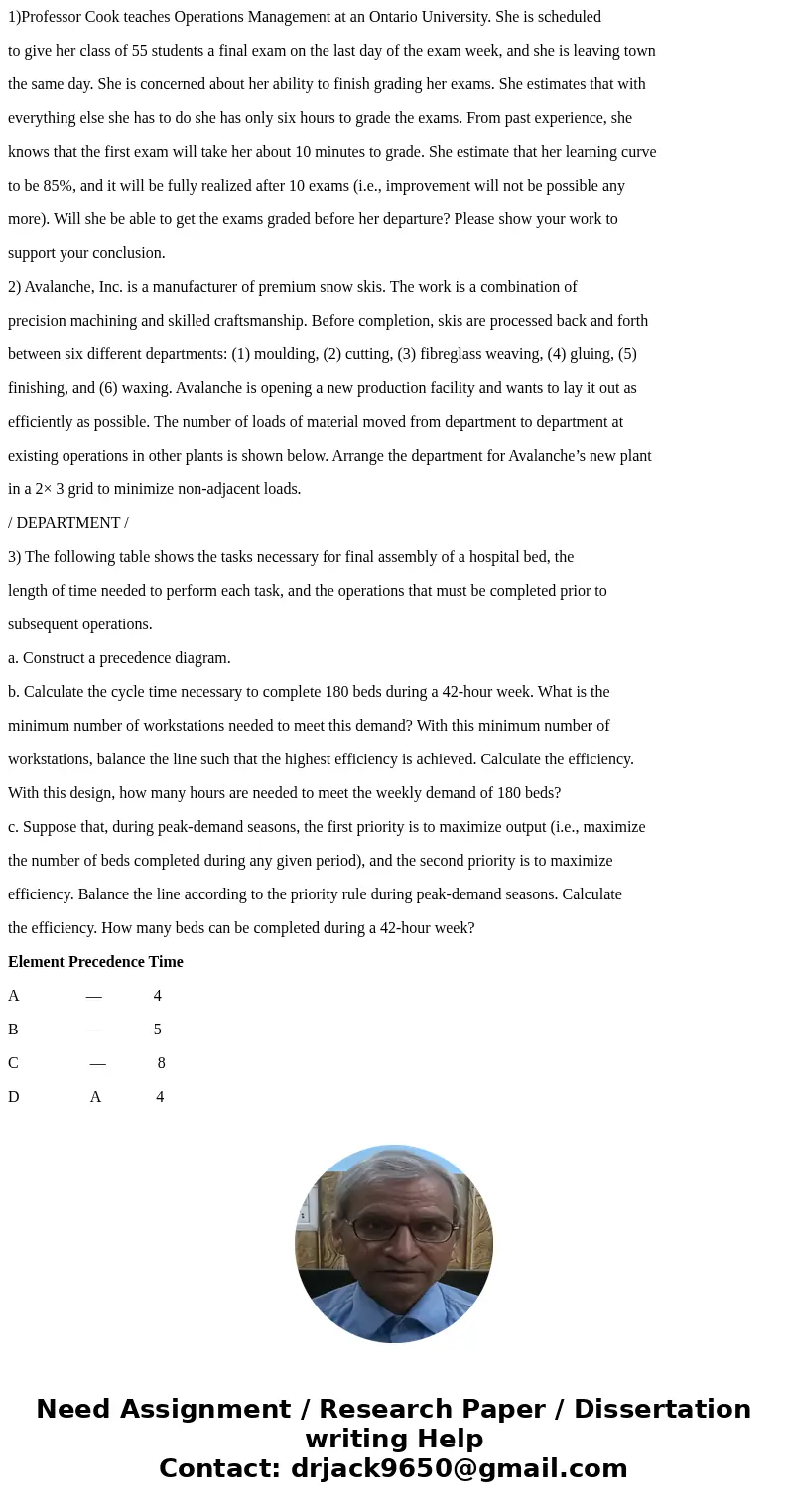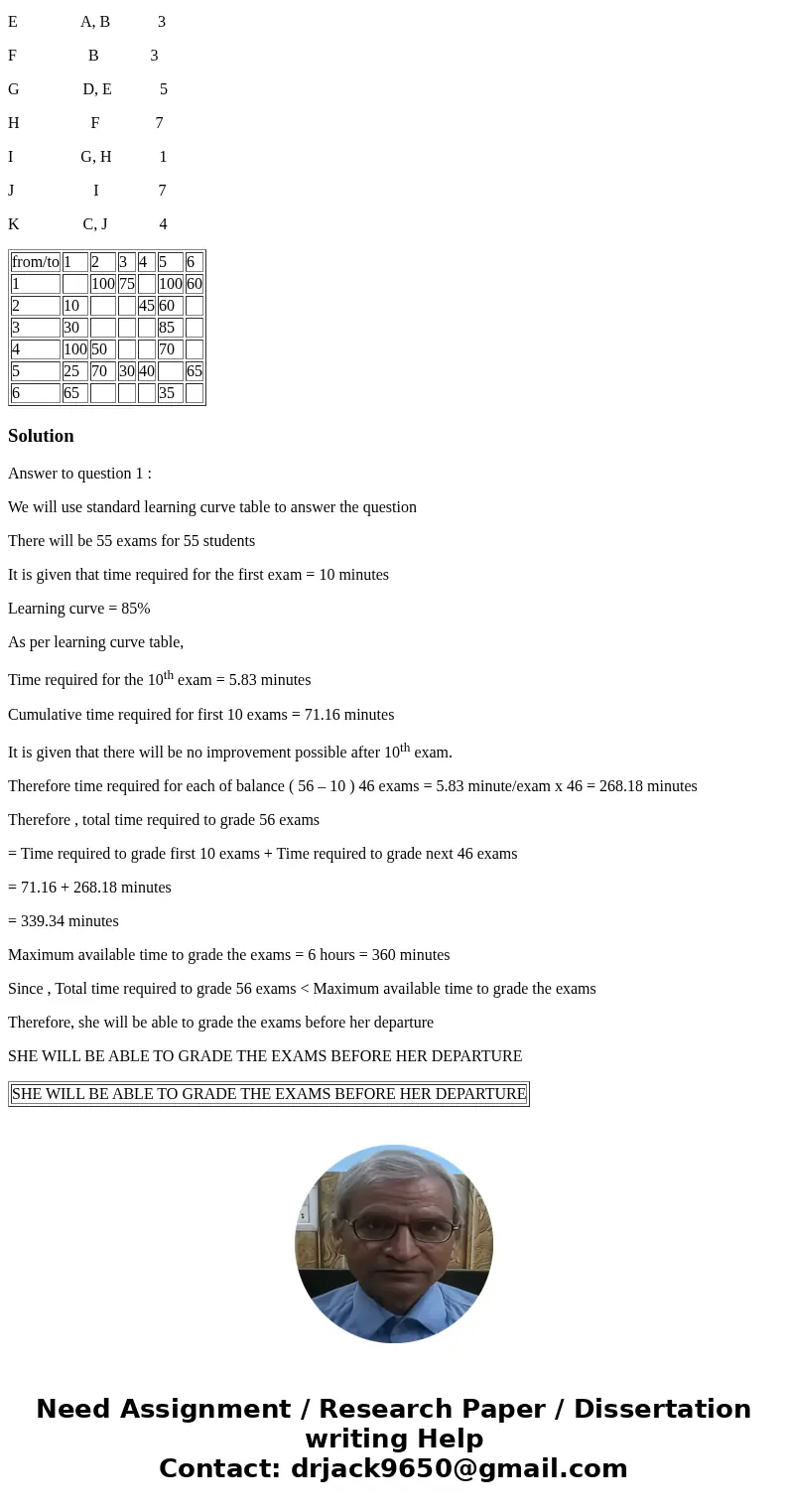1Professor Cook teaches Operations Management at an Ontario
1)Professor Cook teaches Operations Management at an Ontario University. She is scheduled
to give her class of 55 students a final exam on the last day of the exam week, and she is leaving town
the same day. She is concerned about her ability to finish grading her exams. She estimates that with
everything else she has to do she has only six hours to grade the exams. From past experience, she
knows that the first exam will take her about 10 minutes to grade. She estimate that her learning curve
to be 85%, and it will be fully realized after 10 exams (i.e., improvement will not be possible any
more). Will she be able to get the exams graded before her departure? Please show your work to
support your conclusion.
2) Avalanche, Inc. is a manufacturer of premium snow skis. The work is a combination of
precision machining and skilled craftsmanship. Before completion, skis are processed back and forth
between six different departments: (1) moulding, (2) cutting, (3) fibreglass weaving, (4) gluing, (5)
finishing, and (6) waxing. Avalanche is opening a new production facility and wants to lay it out as
efficiently as possible. The number of loads of material moved from department to department at
existing operations in other plants is shown below. Arrange the department for Avalanche’s new plant
in a 2× 3 grid to minimize non-adjacent loads.
/ DEPARTMENT /
3) The following table shows the tasks necessary for final assembly of a hospital bed, the
length of time needed to perform each task, and the operations that must be completed prior to
subsequent operations.
a. Construct a precedence diagram.
b. Calculate the cycle time necessary to complete 180 beds during a 42-hour week. What is the
minimum number of workstations needed to meet this demand? With this minimum number of
workstations, balance the line such that the highest efficiency is achieved. Calculate the efficiency.
With this design, how many hours are needed to meet the weekly demand of 180 beds?
c. Suppose that, during peak-demand seasons, the first priority is to maximize output (i.e., maximize
the number of beds completed during any given period), and the second priority is to maximize
efficiency. Balance the line according to the priority rule during peak-demand seasons. Calculate
the efficiency. How many beds can be completed during a 42-hour week?
Element Precedence Time
A — 4
B — 5
C — 8
D A 4
E A, B 3
F B 3
G D, E 5
H F 7
I G, H 1
J I 7
K C, J 4
| from/to | 1 | 2 | 3 | 4 | 5 | 6 |
| 1 | 100 | 75 | 100 | 60 | ||
| 2 | 10 | 45 | 60 | |||
| 3 | 30 | 85 | ||||
| 4 | 100 | 50 | 70 | |||
| 5 | 25 | 70 | 30 | 40 | 65 | |
| 6 | 65 | 35 |
Solution
Answer to question 1 :
We will use standard learning curve table to answer the question
There will be 55 exams for 55 students
It is given that time required for the first exam = 10 minutes
Learning curve = 85%
As per learning curve table,
Time required for the 10th exam = 5.83 minutes
Cumulative time required for first 10 exams = 71.16 minutes
It is given that there will be no improvement possible after 10th exam.
Therefore time required for each of balance ( 56 – 10 ) 46 exams = 5.83 minute/exam x 46 = 268.18 minutes
Therefore , total time required to grade 56 exams
= Time required to grade first 10 exams + Time required to grade next 46 exams
= 71.16 + 268.18 minutes
= 339.34 minutes
Maximum available time to grade the exams = 6 hours = 360 minutes
Since , Total time required to grade 56 exams < Maximum available time to grade the exams
Therefore, she will be able to grade the exams before her departure
SHE WILL BE ABLE TO GRADE THE EXAMS BEFORE HER DEPARTURE
| SHE WILL BE ABLE TO GRADE THE EXAMS BEFORE HER DEPARTURE |


 Homework Sourse
Homework Sourse